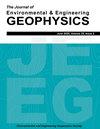基于路边MASW测量的地下剖面:多源和离线距离的影响
IF 0.7
4区 工程技术
Q4 ENGINEERING, GEOLOGICAL
引用次数: 0
摘要
路边MASW测量利用交通产生的表面波信号进行地下表征,因此可以成为一种有用的地球物理方法,特别是在城市地区。然而,这种来自车辆在不规则路面或来源上移动的信号会产生复杂的多源和多方位特征的现场记录。如果这些源存在于接收范围内,则称为内线源;如果存在于接收范围外,则称为外线源。在路边测量中,接收器扩展被放置在外面并与道路中心线平行,从而相对于道路上的源产生离线距离。本研究通过实验研究确定线内源或线外源的存在以及源定位的离线距离对路边MASW记录色散成像的影响。在相邻道路的不同位置故意设置了人工障碍,以确定线内和线外源的影响。此外,将接收器阵列放置在相对于相邻道路中心线的不同离线距离上,以评估离线距离对色散成像和随后的横波速度剖面的影响。研究发现,线内源获得的色散图像比线外源获得的色散图像具有更好的分辨率。此外,只要原始波场记录没有污染和相互干扰,在数据采集过程中存在多个源并不一定会对色散成像产生任何有害影响。随着脱机距离的增加,交通源信号的强度减小。典型地观察到,在脱机距离15 m之外,仍然没有可识别的能量来获得清晰的色散图像。通过对井眼、路边、主动和被动远程MASW测量获得的横波速度曲线进行对比研究,发现了一个令人满意的匹配,从而表明路边MASW测量的可用性,特别是在离线距离不是很大的情况下。本文章由计算机程序翻译,如有差异,请以英文原文为准。
Subsurface Profiling Using Roadside MASW Survey: Influence of Multiple Sources and Offline Distance
Roadside MASW survey utilizes traffic-generated surface wave signals for subsurface characterization and, thus, can be a useful geophysical method, especially in urban areas. However, such signals originating from vehicular movements over road surface irregularities, or sources, produce complex field records of multi-source and multi-azimuthal characteristics. Such sources are termed intra-line if they exist within the receiver spread and outer-line when they exist outside the receiver spread. In a roadside survey, the receiver spread is placed outside and parallel to the centreline of the road, thereby creating an offline distance with respect to the sources on the road. In this study, experimental investigations are conducted to determine the influence of the presence of intra-line or outer-line sources and offline distances of source positioning on the dispersion imaging of roadside MASW records. Artificial hurdles were placed deliberately at different positions on an adjacent road to determine the influence of intra-line and outer-line sources. Furthermore, receiver arrays were placed at varying offline distances with respect to the centreline of the adjacent road to assess the effect of offline distance on the dispersion imaging and subsequent shear wave velocity profile. The study finds that the dispersion images obtained from the intra-line source have better resolutions compared to those obtained from the outer-line source. Further, the presence of multiple sources during the data acquisition does not necessarily shed any detrimental influence on dispersion imaging as long as there is no contamination and mutual interferences of the raw wavefield records. As the offline distance increases, the intensity of the traffic-generated source signal diminishes. It is observed typically for the studied site that beyond an offline distance of 15 m, there remains no recognizable energy to obtain a distinct dispersion image. A comparative study of the shear wave velocity profiles obtained from a borehole, roadside, active, and passive remote MASW surveys revealed an agreeable match, thereby indicating the usability of the roadside MASW survey, especially when offline distance is not enormously large.
求助全文
通过发布文献求助,成功后即可免费获取论文全文。
去求助
来源期刊

Journal of Environmental and Engineering Geophysics
地学-地球化学与地球物理
CiteScore
2.70
自引率
0.00%
发文量
13
审稿时长
6 months
期刊介绍:
The JEEG (ISSN 1083-1363) is the peer-reviewed journal of the Environmental and Engineering Geophysical Society (EEGS). JEEG welcomes manuscripts on new developments in near-surface geophysics applied to environmental, engineering, and mining issues, as well as novel near-surface geophysics case histories and descriptions of new hardware aimed at the near-surface geophysics community.
 求助内容:
求助内容: 应助结果提醒方式:
应助结果提醒方式:


